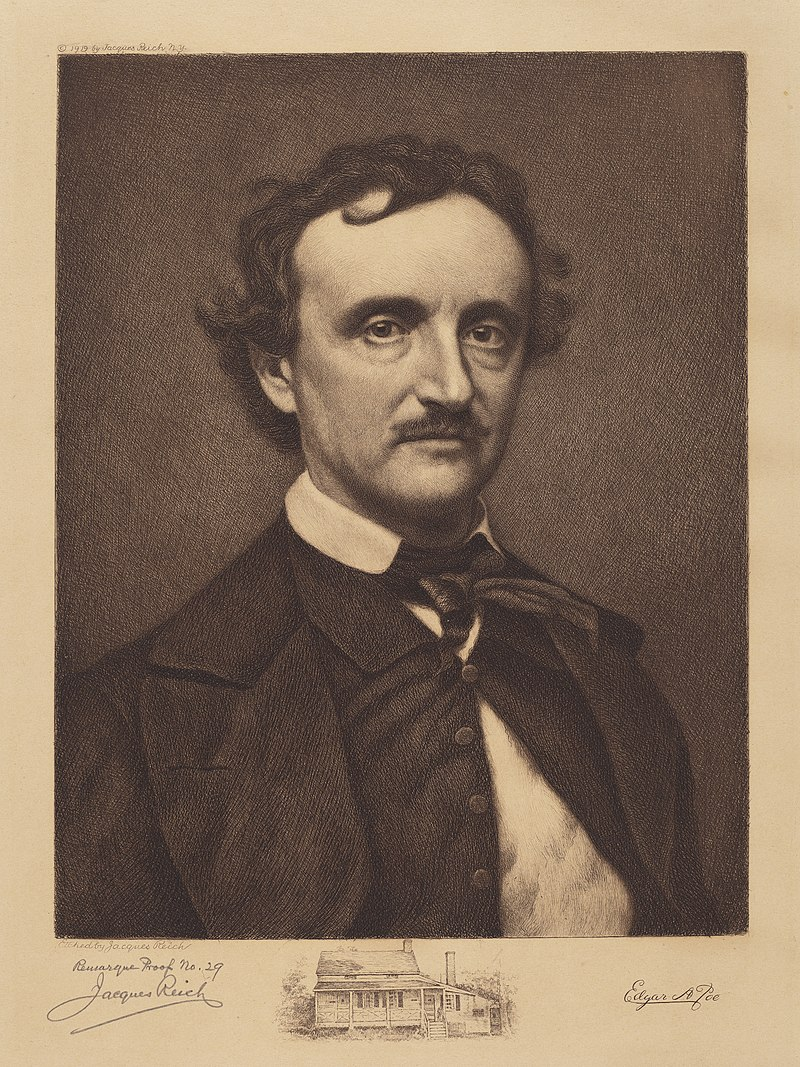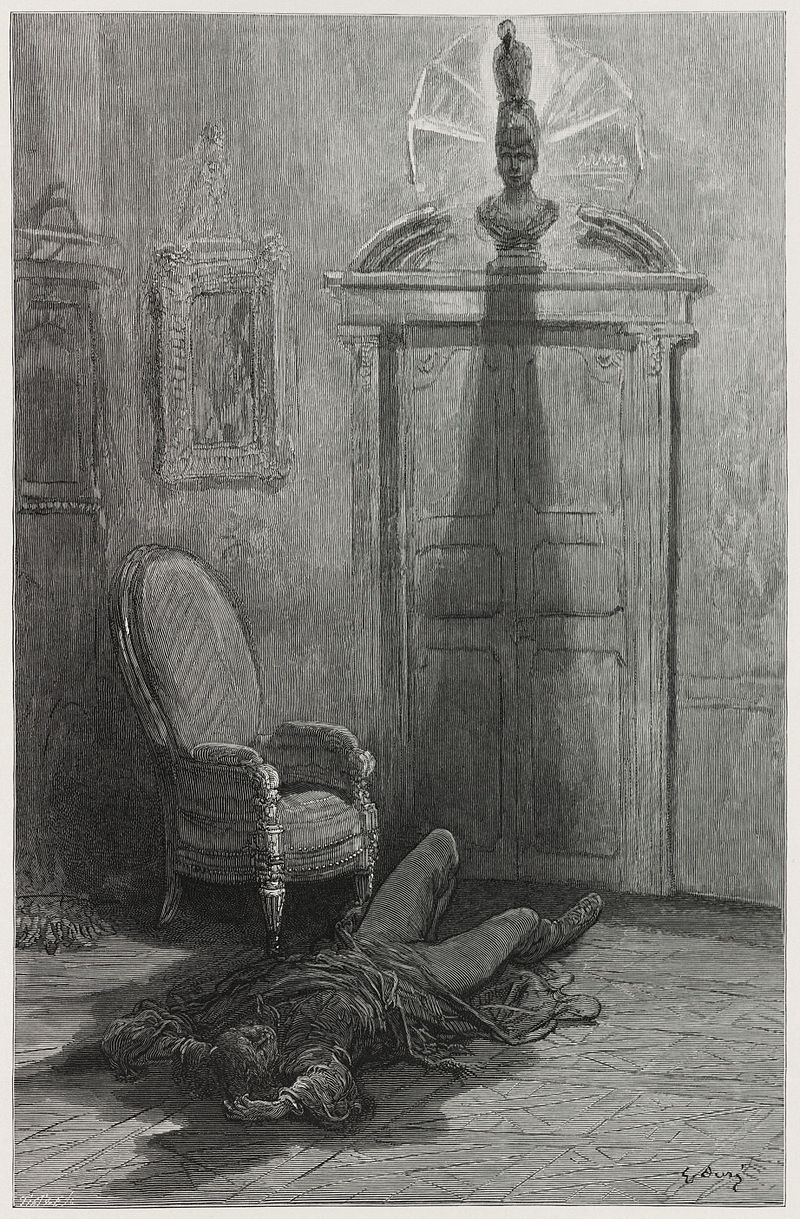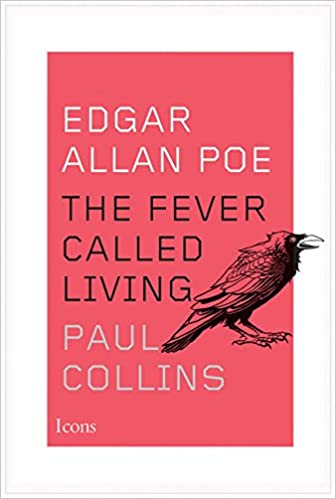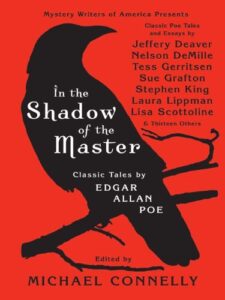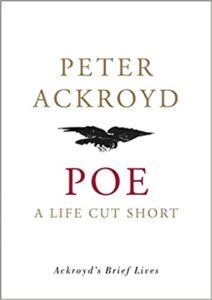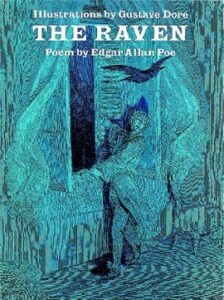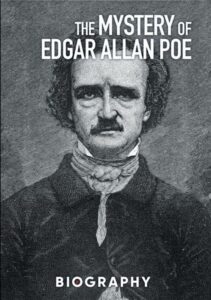LIBRARY BLOG
The Poetry Nook
Into the Madness with Edgar Allan Poe’s The Raven
A Short and Tragic Life
Edgar Allan Poe’s life was bookended in tragedy. Born in 1809, Poe was abandoned by his father, and then orphaned when his mother passed away when he was two. He was taken in by wealthy slave trader John Allan and his wife, but having access to a quality education, travel, and a nice place to live, didn’t overcome Poe’s feeling of otherness – of not quite fitting. This was made even more poignant by the fact that his new family never officially adopted him.
As a young man, Poe was no stranger to vice and regularly took to the bottle and gambling to soothe himself. These activities caused Allan to cut Poe off financially, forcing Poe to drop out of college after just one semester. There was a brief reconciliation between Allan and Poe when Allan’s wife died in 1830, but the bitterness Poe felt towards Allan soon ran their relationship into ruin with Poe, “… claiming that Allan supported his several illegitimate children better than he did Poe” (Napierkowski and Ruby, pp. 199-217).
It was during this tumultuous time, that Poe began writing and publishing his poetry. His work eventually got the notice of wealthy businessman John Kennedy who secured Poe his first job as an assistant editor at the Southern Literary Messenger. Over the next several years, Poe jumped from magazine to magazine, his alcoholism playing as big a part as his ambition to move up in the literary world.
His marriage to his 13-year-old cousin, Virginia, and her untimely death seven years later, is credited to inspiring The Raven, his first national success. Despite its popularity, Poe only ever made nine dollars from the poem — the original amount paid to him by the magazine. Poe was destined to be destitute and made most of his meager living off of lecturing and performing public readings of The Raven.
Poe died at the young age of 40, and the cause of this death is still a mystery. Some say that he died from drinking or overdosing on laudanum, while wilder theories suggest he had rabies or was poisoned. To top off his short life with even more tragedy, Rufus Griswold, one of Poe’s arch rivals, who would later come to write a salacious biography on Poe, secured the rights to Poe’s works and made a fortune publishing them.
The Downward Spiral: A How-To Manual
Poe was a master when it came to manipulating language, its sound and its symbolism. And his work in The Raven does not disappoint. His imagery, interwoven with the meter and rhyme schemes he employees, whips the reader into a frenzy of unrest and desperation until the collapse at the final “nevermore.”
The Raven, in its most distilled form, is a story about grief-about how it can consume you and haunt you. In his poem, Poe layers his melancholic images and builds on his symbolism, so that the reader can feel the physical weight of grief along with the narrator. He sits alone in his dim, candle-lit room on a dreary, rainy night, his fireplace sputtering as he dozes off while paging through his book.
And then there’s the tap.
Our narrator tries convincing himself, and does so poorly I might add, that this incessant tapping is just a late-night visitor, but when he opens the door the only thing there to greet him is more darkness.
And then there’s the tap again.
Desperate to find an explanation, our narrator calls out the name of his lost love. But, it’s not Lenore that he finds tapping at his window. It is that dark beast from Pluto’s shore – the raven.
Poe is no stranger to Greek mythology, he relies on it, and his audiences’ familiarity with it, to build the madness in his poem. The two most potent symbols in Poe’s poem are the raven and the bust of Pallas on which it is perched. Ravens, tools of Apollo, the god of prophecy, have long been signs of ill-omens, messengers of doom. And here, in this poem, the bird hands down the dreadful message, “Nevermore.” More chilling is that the raven chooses to perch on top of the bust of Pallas, also known at Athena, the goddess of wisdom. It literally overtakes sane and rational thought with its foreboding dispatch. It is from here that the world tips and spills our narrator into spiral.
Two additional tools that Poe employs to take the reader along on this downward spiral is the rhythm of the poem, in this case trochaic octameter, and his use of assonance and consonance. Trochaic octameter, a seldom used meter, sets a steady pace of eight trochaic feet per line. Each trochaic foot consists of one stressed syllable followed by and unstressed one. The steady dah-dum dah-dum patter of the poem, under the hand of a less talented writer, would lull the reader into a dreamy trance but, with Poe at the helm, there is panicked energy coursing through the lines, thanks to his unusual rhyme schemes employed through assonance, an internal rhyme with vowels (think soul and outpour) and consonance, an internal rhyme with consonants (shutter and flutter). This turns what could be a plodding walk into a frenzied spiral into madness.
And lastly, there is the repetition. In The Raven, the repetition is incessant and it is everywhere. We just touched on the repeated, beating rhythm of the poem, and the repetition of sound with assonance and consonance. But there is also repeated imagery and language — the memory of Lenore, the grief, the raven, and of course, the “Nevermore.” All of these combines to hound the reader, and they find their own grief, their forgotten loves, nipping at their heels and tapping at their door.
In his short life, Edgar Allan Poe gave us a tremendous gift with his writing. The father of the modern-day detective story, Poe also gave us mountains of gothic horror in both poetry and short story format. Of these, none is so readily recognizable at The Raven. It is both a masterclass in using poetic form for storytelling and a warning of the inescapable misery of grief. Writers to this day, still attempt to harness the magic and madness of this poem and to find a way to escape the eternity of “nevermore.”
Writing Prompt
This month, we are going to tell our own personal version of The Raven. I would like you to think of something that terrifies you, much like the permanence of grief and loss terrified Poe. Once you have identified that fear, pick an animal from mythology to help guide you through it. I recommend checking out the UXL Encyclopedia of World Mythology, available online through our Gale Virtual Reference Library.
I would love to read what you write! Send your poem to me at nmagola@mytpl.org. If you’d like, we can even share it on our Facebook page for others to enjoy.
Recommended Books and Documentaries
References
- Peeples, Scott. “The Raven.” American History Through Literature 1820-1870, edited by Janet Gabler-Hover and Robert Sattelmeyer, vol. 3, Charles Scribner’s Sons, 2006, pp. 953-957. Gale eBooks, https://link.gale.com/apps/doc/CX3450700207/GVRL?u=lln_pterr&sid=GVRL&xid=2dd0b5f0. Accessed 12 Oct. 2020.
- Poe, Edgar Allan. “The Raven by Edgar Allan Poe.” Poetry Foundation, Poetry Foundation, www.poetryfoundation.org/poems/48860/the-raven. Accessed 12 Oct. 2020.
- “The Raven.” Poetry for Students, edited by Marie Rose Napierkowski and Mary Ruby, vol. 1, Gale, 1998, pp. 199-217. Gale eBooks, https://link.gale.com/apps/doc/CX2690900023/GVRL?u=lln_pstat&sid=GVRL&xid=25c9b7dd. Accessed 2 Oct. 2020.
- UXL Encyclopedia of World Mythology. Vol. 1, UXL, 2009. Gale eBooks, https://link.gale.com/apps/pub/1WXB/GVRL?u=lln_pterr&sid=GVRL. Accessed 12 Oct. 2020.
– Naomi Hurtienne Magola, Youth Services Librarian

